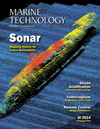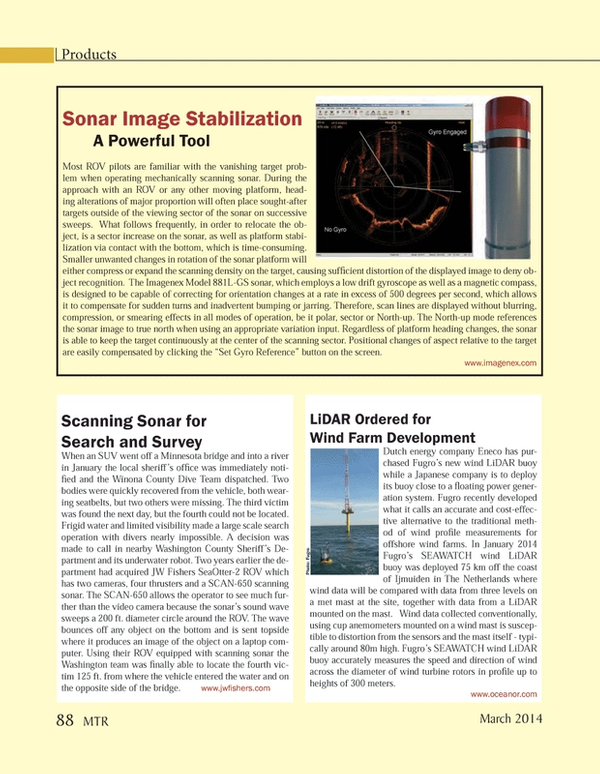
Sonar Image Stabilization A Powerful Tool
Most ROV pilots are familiar with the vanishing target problem when operating mechanically scanning sonar. During the approach with an ROV or any other moving platform, heading alterations of major proportion will often place sought-after targets outside of the viewing sector of the sonar on successive sweeps. What follows frequently, in order to relocate the object, is a sector increase on the sonar, as well as platform stabilization via contact with the bottom, which is time-consuming. Smaller unwanted changes in rotation of the sonar platform will either compress or expand the scanning density on the target, causing sufficient distortion of the displayed image to deny object recognition. The Imagenex Model 881L-GS sonar, which employs a low drift gyroscope as well as a magnetic compass, is designed to be capable of correcting for orientation changes at a rate in excess of 500 degrees per second, which allows it to compensate for sudden turns and inadvertent bumping or jarring. Therefore, scan lines are displayed without blurring, compression, or smearing effects in all modes of operation, be it polar, sector or North-up. The North-up mode references the sonar image to true north when using an appropriate variation input. Regardless of platform heading changes, the sonar is able to keep the target continuously at the center of the scanning sector. Positional changes of aspect relative to the target are easily compensated by clicking the “Set Gyro Reference” button on the screen.
www.imagenex.com
(As published in the March 2014 edition of Marine Technology Reporter - www.seadiscovery.com)
Read Sonar Image Stabilization A Powerful Tool in Pdf, Flash or Html5 edition of March 2014 Marine Technology
Other stories from March 2014 issue
Content
- Europe’s Seas Under Threat page: 12
- Human Powered Subs page: 14
- UK North Sea Activity Report page: 16
- Bibby Offshore Invests in Fleet page: 18
- CSS Olympia Delivered to GranEnergia page: 18
- Blyth Workcat Joins Osiris Projects Survey Fleet page: 20
- Sonar & the USCG page: 22
- Five Minutes with Hydroid President Duane Fotheringham page: 26
- Advances in Robotic Vehicle Technology page: 32
- There’s an App for That! page: 38
- Expect the Unexpected: Acidic Oceans page: 44
- X (Prize) Marks the Spot page: 52
- D-Day Mapping Mission page: 56
- 3D Imagining: Real-time with SAS page: 62
- I can see clearly now ... Via Resolution Optics page: 66
- New MASK Unveiled page: 72
- Interview: Global Diving & Salvage CEO Devon Grennan page: 76
- MacArtney's Record Growth in North America page: 83
- OI 2014 Technology Preview page: 84
- Sonar Image Stabilization A Powerful Tool page: 88
- Scanning Sonar for Search and Survey page: 88
- LiDAR Ordered for Wind Farm Development page: 88
- New Compact in situ pCO2 Sensor page: 89
- BIRNS Millennium Connectors page: 89
- New Survey Interface page: 89
- Engineered Syntactic Systems Expands Buoyancy Offering page: 90
- Sonardyne Ranger 2 Chosen for Russian Salvage Vessel page: 90
- New Broco Underwater Cutting Rod page: 90
- Shark Marine Launches D.A.S. Boat page: 91
- Kongsberg Camera Systems for OOI page: 91


